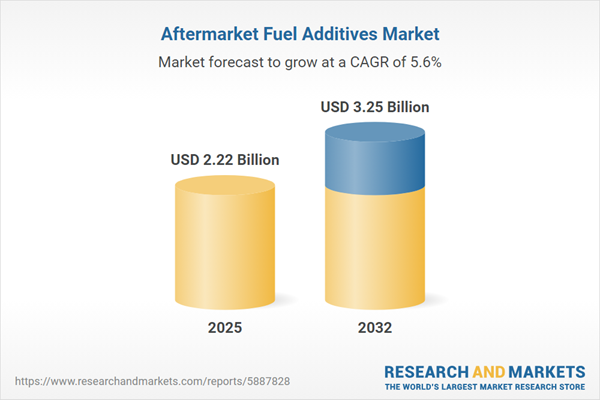Speak directly to the analyst to clarify any post sales queries you may have.
The aftermarket fuel additives market is a pivotal resource for organizations striving to safeguard fleet reliability, comply with evolving standards, and optimize performance across high-demand transportation and industrial environments. Leaders in logistics, shipping, and heavy industry must navigate a landscape increasingly shaped by regulatory shifts, proactive asset management, and the adoption of innovative solutions.
Market Snapshot: Aftermarket Fuel Additives Market Overview
The global aftermarket fuel additives market is projected to increase from USD 2.11 billion in 2024 to USD 2.22 billion in 2025, setting a pathway toward an estimated USD 3.25 billion by 2032. This anticipated expansion, driven by a steady CAGR of 5.58%, is underpinned by rising efficiency expectations, regulations targeting emissions, and sustained investment in advanced additive technologies. As businesses spanning logistics, shipping, and agriculture align operational models with these emerging trends, aftermarket fuel additives have moved to the forefront of asset management and strategic planning, helping organizations modernize fleets and address cost, compliance, and maintenance priorities.
Scope & Segmentation of the Aftermarket Fuel Additives Market
- Product Types: Cetane improvers, combustion catalysts, fuel injector cleaners, octane boosters, and stabilizers all provide performance safeguards for both traditional and advanced engine models, supporting ongoing maintenance programs.
- Vehicle Types: Additives are suitable for diesel and gasoline engines, with coverage across commercial trucks, passenger vehicles, marine equipment, and agricultural machinery, ensuring that a range of operational needs are met for diverse business fleets.
- Application Areas: Fleet operators in commercial transport, marine shipping, passenger services, and agricultural sectors consistently incorporate additives to streamline maintenance, contain service costs, and drive continuous uptime for critical assets.
- Distribution Channels: Access to aftermarket fuel additives is facilitated through specialized trade retailers, authorized service networks, responsive e-commerce channels, and flexible subscription models, all supporting robust sourcing strategies.
- Package Formats: Solutions are delivered in liquid, sachet, and tablet forms, giving organizations precise options for scheduled maintenance and rapid-response needs, and allowing for efficient inventory control across disparate asset types.
- Geographic Regions: The aftermarket fuel additives market spans the Americas, Europe, the Middle East & Africa, and Asia-Pacific, where regional fuel standards, infrastructure, and localized regulations influence purchases, specification requirements, and deployment approaches.
Key Takeaways for Senior Decision-Makers
- Adopting aftermarket fuel additives is critical to maintaining both regulatory alignment and uninterrupted operations across varied and geographically dispersed fleets.
- Recent technological advances improve additive compatibility with new and legacy engines, allowing for simplified integration as fuel types and vehicle technologies evolve.
- Digital procurement systems and automated inventory management tools empower leaders to monitor costs, secure reliable supply chains, and respond effectively to changes in policy or operational tempo.
- Centralized tracking and oversight of additive use promote consistent management across multiple sites, facilitating expansion and the harmonization of operational standards.
- Strategic collaborations among additive manufacturers, certified service providers, and end-users elevate quality and enable organizations to demonstrate measurable gains in performance and compliance.
Tariff Impact: Navigating Changing Cost Structures
Shifting U.S. tariffs on core chemical feedstocks are driving a reassessment of procurement strategies, with many companies strengthening regional supplier relationships to ensure continuity. Enhanced procurement and inventory management tools are proving essential in managing exposure to tariff fluctuations and supporting operational resilience.
Methodology & Data Sources
The insights in this report are based on interviews with channel experts, comprehensive reviews of market data, and a close examination of evolving regulatory frameworks. Executive discussions contributed to practical guidance for organizations managing complex procurement and fleet maintenance requirements.
Why This Report Matters
- Senior executives gain direct, data-backed guidance on aftermarket fuel additives, technological advancements, and regulatory developments pertinent to strategic fleet and asset planning.
- Segment-specific recommendations deliver actionable support for improving procurement efficiency, compliance management, and responsiveness to shifting market needs.
- The report’s frameworks empower organizations to prioritize risk reduction, foster resilience, and adapt swiftly in an ever-shifting operational landscape.
Conclusion
Sustained asset reliability and compliance hinge on agile responses to regulatory and technical change. Advanced aftermarket fuel additives enable organizations to strengthen operational resilience, ensure regulatory readiness, and maintain continuity across dynamic industry conditions.
Additional Product Information:
- Purchase of this report includes 1 year online access with quarterly updates.
- This report can be updated on request. Please contact our Customer Experience team using the Ask a Question widget on our website.
Table of Contents
3. Executive Summary
4. Market Overview
7. Cumulative Impact of Artificial Intelligence 2025
Companies Mentioned
The companies profiled in this Aftermarket Fuel Additives market report include:- Infineum International Limited
- The Lubrizol Corporation
- Afton Chemical Corporation
- Innospec Inc.
- BASF SE
- Evonik Industries AG
- Chevron U.S.A. Inc.
- Clariant AG
- Ashland Global Holdings Inc.
- BG Products, Inc.
Table Information
| Report Attribute | Details |
|---|---|
| No. of Pages | 185 |
| Published | October 2025 |
| Forecast Period | 2025 - 2032 |
| Estimated Market Value ( USD | $ 2.22 Billion |
| Forecasted Market Value ( USD | $ 3.25 Billion |
| Compound Annual Growth Rate | 5.5% |
| Regions Covered | Global |
| No. of Companies Mentioned | 11 |









